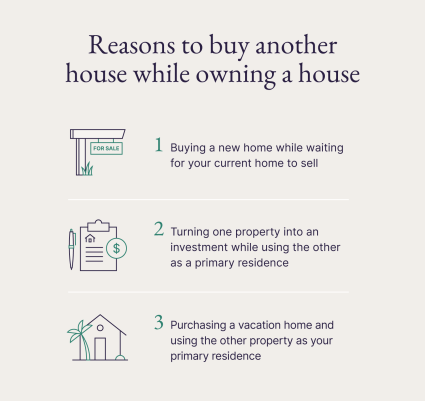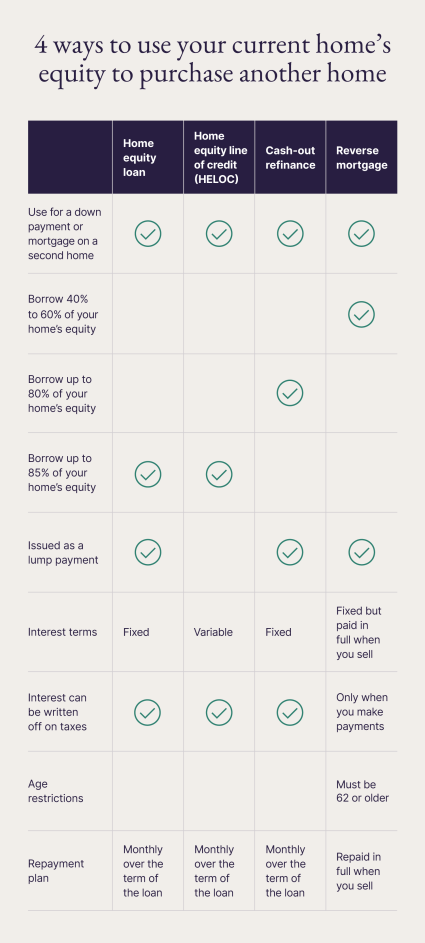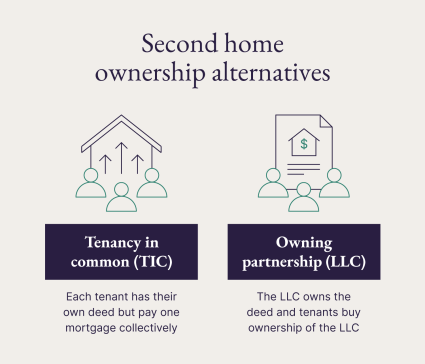
1. Get approved for another mortgage
Best for: When you plan to keep both homes long term and already have a down payment Perhaps the simplest and most familiar strategy for buying another house is to apply for a new mortgage. In this strategy, a bank approves you to hold two separate mortgages simultaneously. You’ll need to have enough cash on hand to cover a down payment and the closing costs for the new mortgage.Use a second home calculator to determine how much money to budget for a second home to help you see whether you can afford two mortgages.| Pros | Cons |
| The process is the same as applying for your first mortgage, so it’s familiar. | Debt-to-income ratio limits and excellent credit requirements make it difficult for most people to qualify for another mortgage.You may need a larger down payment since most special down payment programs don’t apply to secondary mortgages. |
Luxury second homes
2. Become a landlord
Best for: When you only plan to live in one residence or are buying the second home as an investmentSimilar to getting approved for two mortgages, as a landlord you are still responsible for two monthly mortgage payments, but the rental income can help cover your payments. If you plan to rent out your second home, read your mortgage agreement carefully. Some mortgage agreements prohibit you from renting it out or require you to get the lender’s permission. Once you’ve confirmed you can rent out your home, get it appraised so you can determine how much to charge for rent. The amount you charge should cover your monthly mortgage payment on the property. Your lender may also require you to have at least 2% of the mortgage value in investments, cash, etc. to cover the mortgage if you cannot get a tenant.| Pros | Cons |
| You will only pay one mortgage out of pocket monthly (as long as you have a tenant who covers the payment).You’ll continue to build equity in your first home.You can write off any home improvement and maintenance costs for the home you rent out as business expenses on your taxes each year. | If your tenant doesn’t pay rent or your tenant moves, you’ll need to cover the cost of the mortgage. Failure to cover both mortgages could result in the foreclosure of one or both homes.Being a landlord comes with extra responsibilities such as listing the property, hosting showings, vetting tenants, etc.Taxes for a landlord become more complicated and require careful record keeping. |
3. Take out a bridge loan
Best for: When you are buying your new home while selling your current homeA bridge loan is a temporary loan (usually six months to a year) intended to cover the cost of purchasing a new home while waiting for your current home to sell. Also called a swing loan, a bridge loan can finance up to 80% of the value of both your new and current home. When your current home sells, you use the profits to pay back the entirety of the bridge loan and apply for a traditional mortgage for your new home.| Pros | Cons |
| Bridge loans are a quick way to raise cash to buy your new home before your current one sells. | Bridge loans are hard to qualify for (you must have excellent credit) and often come with hefty fees and higher interest rates than a conventional mortgage and other financing methods. Bridge loans are risky since your current home is used as collateral. If you aren’t able to sell your first home, you could lose both homes. Since the housing crash of 2008, many financial institutions have stopped offering bridge loans. |
4. Borrow from your investments
Best for: When you will be responsible for paying two mortgages, whether temporary or long termGenerally, you cannot withdraw from your retirement investments without paying a penalty (usually 10%) and potentially taxes on the amount you withdraw. However, if you have a 401(k), you may be able to take out a loan. Not all providers offer this feature, but if they do, you can generally borrow:- $10,000 or half your vested account balance (whichever is more)
- A total of $50,000
| Pros | Cons |
| Since you are borrowing from yourself, you won’t need credit approval and the loan won’t appear on a credit check. | Not all 401(k) plans allow you to take out a loan.Opportunity costs are high since any money you take out for the loan won’t be invested, minimizing the amount your account can earn over time.Borrowing limits mean you may only be able to borrow enough for a down payment for a second home, not the entire mortgage amount. |

5. Get a home equity loan
Best for: When you will be responsible for paying two mortgages, whether temporary or long termA home equity loan allows you to borrow up to 85% of your current home’s equity. You can use any lender (not just the lender currently serving your mortgage), so shop around and apply for the best rate. Depending on how much equity you have in your home, you may be able to raise enough funds to cover the cost of the mortgage of your second home or the down payment and closing costs.| Pros | Cons |
| Home equity loans allow you to raise cash without depleting your existing cash on hand.You’ll be able to deduct the interest on your home equity loan just like you do with a mortgage if you take out the home equity loan to buy, build or renovate a primary or secondary residence. | A home equity loan uses your primary residence as collateral, so your home is at risk if you default.You may end up with multiple loan payments. If you use a home equity loan to raise cash for a down payment, you may end up with three: 1) your original mortgage, 2) your home equity loan covering the down payment, and 3) Your second home’s mortgage. |
6. Apply for a home equity line of credit (HELOC)
Best for: When you will be responsible for paying two mortgages, whether temporary or long termA home equity line of credit allows you to borrow against the equity in your home, but it’s not a full balance loan like a home equity loan. Instead, it’s a line of credit you can draw from over time, like a credit card limit. If you have enough equity in your home, you can use your HELOC to cover the entire cost of your new home, or you can just use it for the down payment.| Pros | Cons |
| HELOCs tap into your existing home equity so you can put it toward a second home. | Interest rates are variable, so you may not always be able to borrow at the same rate over time. |
7. Raise a down payment with a cash-out refinance
Best for: When you will be responsible for paying two mortgages, whether temporary or long termWith a cash-out refinance, you refinance the entire value of your home up to 80% of its equity. Whatever you don’t owe on the mortgage you’ll receive in cash. For example, if you have $100,000 left on your mortgage but the home has $500,000 in equity, you’d be able to refinance up to $400,000. You would walk away with $300,000 in cash to put toward the purchase of your second home.| Pros | Cons |
| Just like refinancing your mortgage, you can lower your current mortgage rate if rates are lower than when you initially financed your home.If you can raise enough money in a cash-out to cover the entire cost of your second home, you will end the process with only one monthly mortgage payment. | If mortgage rates are higher than when you initially financed your first home, you may pay a higher rate. |
8. Consider a reverse mortgage
Best for: Seniors looking to purchase a second homeIf you are 62 or older, you may qualify for a reverse mortgage. Also known as a home equity conversion mortgage (HECM), a reverse mortgage allows you to borrow from your home’s equity without making monthly payments — with the expectation that you will pay back the loan when you sell your home.| Pros | Cons |
| You get access to your equity without any additional monthly payments. | You will accrue monthly interest, which will be added to your loan amount. This can quickly eat up your home’s equity.When you pass away, your heirs must sell your home to pay back the mortgage instead of being able to keep the house or the money from the sale, minimizing their inheritance. |

9. Explore other types of ownership
Best for: Peeople purchasing a vacation home with othersThere are other types of home ownership besides sole ownership. If you want to purchase a second home to use as a vacation home while living primarily in your first home, you can choose to purchase a share of a second home. There are two options for owning a home with people unrelated to you:- Tenancy in common (TIC): Each tenant holds a deed for a portion of the home, but they pay one mortgage together.
- Owning partnership/LLC: An owning partnership or limited liability company (LLC) owns the deed to the home, and tenants buy into ownership by purchasing shares of the LLC. You can set up the LLC with the other owners or you can work with Pacaso, who handles the LLC paperwork and the home maintenance for you.
| Pros | Cons |
| A second home is much more affordable when you split the purchase price and maintenance costs with others.Tenants can transfer or sell their shares without the permission of other tenants. | You won’t always know the other tenants.You will have to manage a schedule for the occupancy of the home. |










